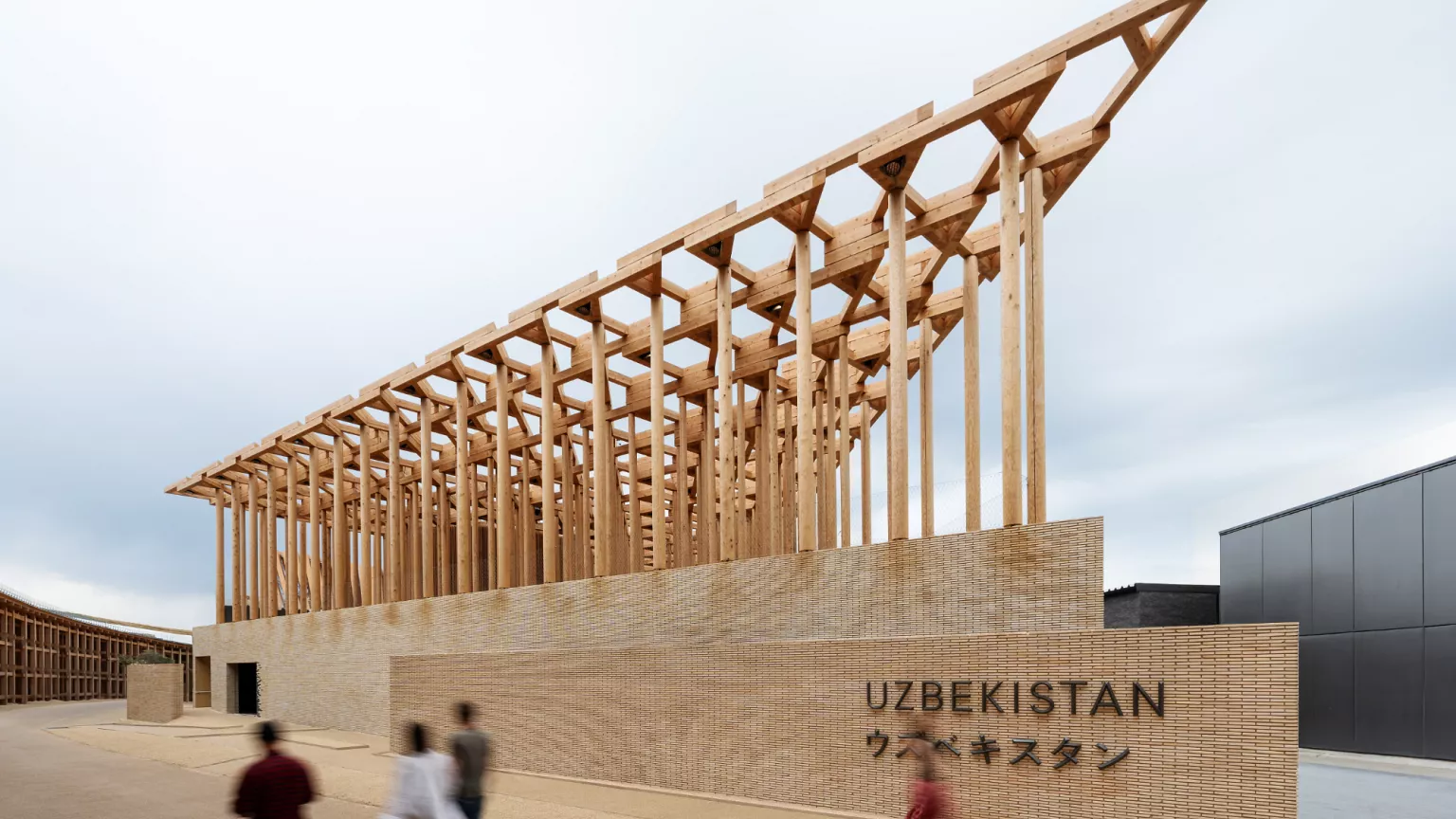
Walking through Sou Fujimoto's magnificent Grand Ring at Expo 2025 Osaka, I watched my seven-year-old daughter's eyes light up at each pavilion.
Walking through Sou Fujimoto's magnificent Grand Ring – a true masterpiece that remained refreshingly cool and breezy even during today's scorching summer heat – I watched my seven-year-old daughter's eyes light up at each pavilion.
However, the sweltering heat highlighted a missed sustainability opportunity. Long queues formed at the limited water refill stations, while vending machines and vendors continued selling plastic water bottles. The elevated skyway besides providing superb views over the entire Expo, but remarkably, also offered water refill stations with no crowds (a hidden secret).
Every pavilion should have featured its own refill station – not just for visitor comfort, but as a powerful statement about reducing single-use plastics and combating climate change. For an Expo themed "Designing Future Society for Our Lives," this oversight felt particularly glaring.

The Evolution of Travel Inspiration
A visit to Expo 2025 Osaka with my daughter became a profound lesson in how destinations can leverage global platforms to inspire high-yield travelers and tap into the powerful realm of passion tourism. As someone who has spent over three decades studying how destinations can authentically connect with visitors, what I observed at Yumeshima Island offers invaluable insights for tourism professionals worldwide.
Granted, we need to recognize that while the national tourism board of the respective countries may have a role to play in their country’s participation at Expo, normally it is other government agencies that lead the organization of their pavillion, mostly the Ministry of of Foreign Affairs or Economy and Trade with a focus on investment.
While tourism for most countries is a priority, it might not be the only or the ultimate priority, as becomes apparent when looking at some of the official pavillion websites – please see a selection: USA , Germany, Canada , Australia , Thailand , France , UAE , Netherlands , Luxembourg , UK , Portugal , Brazil , Nordic countries .
Some countries do not have an official Expo pavillion website, and some confusingly remain under maintenance or construction.

The Popularity Paradox: What Long Lines Really Tell Us
What is the most telling indicator of an Expo pavilion's tourism marketing success? The length of its queue.
It’s worth keeping in mind that the majority of visitors are from Japan, followed by China. So, the China Pavilion had already welcomed nearly 90,000 visitors by late April, averaging over 5,700 guests per day and reaching up to 8,000 on weekends. This is a powerful demonstration of visitor demand that translates directly into destination appeal – thereby demonstrating the effectiveness of combining cultural heritage with technological innovation for diverse visitor segments. The Chinese pavilion’s AI-powered Sun Wukong character, also known as the Monkey King (a literary and religious figure best known as one of the main characters in the 16th-century Chinese novel Journey to the West, who acquires supernatural powers through Taoist practices), creating real-time poetry and art represents the future of interactive destination marketing.
Consistently long lines at the pavilions hosted by the US, France, Germany, Saudi Arabia, Austria, Philippines, China, Singapore, Thailand, Australia, Portugal, Switzerland, Uzbekistan, Qatar, Oman, and Türkiye proved to be more than crowd management challenges. They were proof of successful country branding, and the striking design of their respective pavillions.
Canada's pavilion proved particularly strategic in its approach to the Japanese market. The sophisticated AR storytelling created immersive regeneration narratives that transformed visitors from observers into participants in Canada's sustainability story. This is precisely the type of engagement that resonates with Japanese families who represent high-value tourism segments.
Understanding visitor demographics is crucial for interpreting pavilion popularity. With the Expo's primary audiences being domestic Japanese visitors, plus large numbers of Chinese tourists, the success of certain pavilions directly correlates with their appeal to East Asian travelers.
Countries like Germany and France drawing massive crowds demonstrates their strong brand equity in these markets. The queue length becomes a real-time measurement of destination marketing effectiveness among culturally sophisticated audiences who prioritize cultural depth and thought-provoking breadth over attractions offering superficial immediacy.

Strength-Based Strategy: Countries Playing to Their Advantages
A strength-based strategic approach provides an excellent framework for analyzing which countries are maximizing their 2025 Expo presence for tourism impact. The pavilions drawing the longest queues demonstrate a clear understanding of their unique advantages and how to leverage them effectively with large volumes of visitors of all ages.
Singapore's 17-meter Dream Sphere, consistently packed with visitors, represents masterful strategic thinking. Singapore understands its strengths as an innovation hub, and has connected these to attract tech-passionate travelers. Its pavilion embodies the nation’s aspiration to be where "dreams take shape." The measurable results appear in both queue length and visitor engagement once inside the pavilion.
Australia's Chasing the Sun pavilion, with its perpetual crowds, also exemplifies this approach. Rather than trying to be everything to everyone, Australia identified its strengths in natural beauty and outdoor lifestyle. These are paired with emerging adventure travel trends and an immersive day-to-night experience that makes visitors yearn to discover Australia’s sunrise-to-sunset culture for themselves.
The popularity of these pavilions among Japanese visitors – Expo 2025's primary demographic – demonstrates a sophisticated understanding of what drives travel decisions for Japanese travelers. Queue management becomes a real-time market research study.
The Commons pavilions host a myriad of small countries, mostly developing nations, in a trade-show-like lay out in which each country has a small booth rather than a full pavilion. These are a great places to find stimulating and original travel gems. Personally. the Pakistan pavilion was an eye-catching stand-out, as it was covered in real Himalayan pink salt!

Micro-niches as the Future of Smart Tourism Marketing
Beyond the crowd-drawing powerhouses, the most sophisticated pavilions target specific micro-niches rather than appealing to mass tourism. This strategy becomes even more crucial when considering that most visitors are Japanese travelers – an audience that values depth and cultural sophistication over generic experiences.
Austria's musical pavilion, requiring advance reservations due to popularity, demonstrating how effectively this micro-niche approach works with the Japanese market, masterfully uses interactive technology in its Cathedral of the Future, where visitors can shape AI-driven audiovisual shows. The wooden spiral representing Beethoven's Ode to Joy creates an emotional hook, specifically appeals to music enthusiasts and cultural heritage seekers, but the interactive conclusion drives tourism conversion.
Switzerland's pavilion, with its four interconnected spheres filled with innovation, creates an "interactive and educational playground" experience targets sustainability enthusiasts and innovation seekers rather than traditional leisure travelers. The architectural boldness attracts attention, but the conceptual depth retains engagement from high-yield visitor segments who align with Japanese values around craftsmanship and environmental consciousness.
Countries focusing on traditional crafts and cultural heritage find particular resonance with Japanese visitors. These are exactly the type of travelers who stay longer, spend more, are hungry for cultural experiences, and become destination advocates and ambassadors.
This is passion tourism; travel motivated not by proximity or price, but by deep personal interests and emotional connections. The successful pavilions aren't simply showcasing their countries; they're identifying and sparking specific passions that directly influence travel decisions.

The Interactive Revolution: From Observation to Participation
Our pavilion visits revealed a critical insight: interactivity directly correlates with tourism inspiration. Canada's AR experience had my daughter completely engaged, using augmented reality to explore Canadian wilderness to cityscapes via simulated icebergs. This wasn't passive observation – it was active participation that created lasting emotional memories.
In stark contrast, Mozambique's pavilion, while culturally authentic, offered limited interactive elements. Visitors walked through beautiful displays but left without the deep engagement that drives future travel decisions.

Digital Nomads and the Future Workforce
My daughter's fascination with technology demonstrations was embedded in another crucial trend I observed: the integration of technology narratives with destination marketing. Countries that successfully connect their technological capabilities to remote work opportunities are positioning themselves perfectly for the digital nomad market.
The most forward-thinking pavilions aren't just showcasing technology; they're demonstrating how their countries support the future of work. This represents a nuanced appreciation of how passion tourism intersects with lifestyle trends, particularly relevant for attracting Japanese professionals seeking work-life balance abroad.

The Storytelling Imperative
As founder of the Destination Film Forum, I was particularly impressed by how the best pavilions prioritized storytelling over statistics. While we couldn't enter due to crowds, Italy's pavilion looked magnificent from the outside, and I learned it features actual Caravaggio and Tintoretto works inside – promoting Italian tourism and immersing visitors in Italy's artistic soul.
Vietnam's pavilion exemplified authentic storytelling, and created an immediate emotional connection through their cultural narrative.
This is the essence of effective destination marketing at Expo 2025: creating emotional connections that transcend traditional tourism promotion.

Learning from the Masters
Several pavilions stood out for combining popularity with meaningful visitor engagement.
Japan's host pavilion sets the gold standard with its immersive zones – Plant, Farm, and Factory – exploring sustainability and technology through hands-on interaction. The circular structure celebrates Japanese culture and creates a journey where visitors experience Japan's vision for a future society through meaningful participation.
The US pavilion, packed with cutting-edge technology and featuring a 4D film showcasing AI, space exploration, and autonomous vehicles, demonstrates how technological storytelling can appeal to diverse visitor demographics. The guided group format, while creating longer queues, ensures thoughtful engagement with American innovation narratives.
The Future of Life pavilion by roboticist Hiroshi Ishiguro represents the apex of interactive destination marketing. The Changing Waters AR experience invites visitors to interact with water through digital overlays, creating shifting light patterns across the pavilion's surface. This technological interactivity creates unforgettable memories that drive destination consideration.

The High-Yield Traveler Strategy
What became clear during our visit is that the most sophisticated pavilions strategically target travelers who represent higher value: the culturally curious, the sustainability-conscious, the technology enthusiasts, and the authenticity seekers. These aren't tourists looking for a cheap package deal; they're travelers willing to invest in experiences that align with their passions.
Brazil's pavilion demonstrated how their "poetic, sensory journey" approach through sound, art, and agroforestry innovation created emotional connections that static displays simply cannot achieve.
Countries that understand this are showcasing pavilion experiences underpinned by detailed market research. They have identified which aspects of their offerings generate the strongest emotional responses and use this data to inform their broader tourism strategies.
Tune in to our featured High-Yield Tourism Podcast episode on EXPO 2025 in Osaka (everywhere you get your podcasts) to explore how global expos are evolving and what this means for tourism professionals everywhere:

The Parent Test
Perhaps the most telling indicator of a pavilion's tourism potential was what I call "the parent test." Which pavilions made parents start researching flights before we even left?
And here is a new reality: AI in the hands of young kids. Which pavillions prompted my 7-year old daughter to turn to her trusted ChatGPT friend to find more information and get her probing questions answered based on what she experienced in the pavillions? The answer is those that combine strong visual appeal (evidenced by long queues) with meaningful interactivity.
When my daughter asked if we could visit Canada to see more of their nature conservation programs after the AR experience, or when she wanted to explore Peru's biodiversity after our pavilion visit, those countries had succeeded in converting Expo visitors into future travelers.
Kudos to Canada for giving us the VIP treatment as Canadian citizens, but unfortunately Germany did not do the same for fellow Germans, and simply turned us away. For a little girl with three passports, Canada became her favorite because of our inspiring Canadian pavillion vist at Expo 2025 Osaka.
The pavilions we couldn't enter due to crowds – the US, France, Germany, Saudi Arabia – created destination aspiration through sheer popularity. When children see hundreds of people queuing for something, it automatically elevates that country's desirability. This crowd psychology becomes powerful destination marketing, especially for family visitors who represent high-value tourism segments.

Beyond the Expo: Sustainable Inspiration
Countries demonstrating how they're addressing global challenges while maintaining their own cultural identity also proved highly popular. This resonates powerfully with high-yield travelers, who increasingly choose destinations based on values alignment. Countries understanding this dynamic are positioning themselves for significant tourism dividends.
Luxembourg's "Doki Doki" pavilion, which will repurpose its materials for a nature adventure theme park, exemplifies this approach. It both promotes Luxembourg and demonstrates a national commitment to circular economy principles that resonate with environmentally conscious travelers.

The Verdict
Expo 2025 Osaka proves that the future of destination marketing lies in understanding and nurturing traveler passions rather than promoting generic attractions. The countries succeeding here have mastered the art of identifying their unique strengths, connecting them to specific traveler aspirations, and curating experiences that inspire emotional connections.
As we walked back through the Grand Ring at sunset, my daughter clutching her Expo passport filled with stamps from the pavilions we had visited, I realized we had witnessed the future of destination inspiration. The countries that recognize Expo visitors as potential ambassadors for their unique stories will reap the benefits long after October 13, when the last pavilion closes its doors.
For tourism professionals, the lesson is clear: stop trying to be everything to everyone. Instead, identify your unique strengths, understand the passions that drive your ideal visitors, and create experiences that transform casual interest into deep emotional connection.
That's how you inspire the kind of travelers who don't just visit – they return, they recommend, and they become part of your destination's story.
Tune in to our featured High-Yield Tourism Podcast episode on EXPO 2025 in Osaka (everywhere you get your podcasts) to explore how global expos are evolving and what this means for tourism professionals everywhere:
Dr. Jens Thraenhart is co-founder of High-Yield Tourism, as well as the Founding Partner & CEO of Chameleon Strategies, representing the United Nations World Tourism Organization Affiliate Members Board as 2nd Vice Chair. He advises tourism boards and hotel companies, currently the Saudi Tourism Authority, and has served as CEO of Barbados Tourism Marketing Inc., Executive Director of the Mekong Tourism Coordinating Office, and senior executive roles at Destination Canada and Fairmont Hotels & Resorts. He co-founded various ventures, including Dragon Trail (China), Destination Mekong, Destination Film Forum, Enwoke, Digital Innovation Asia, and Blogger Match-up.




















